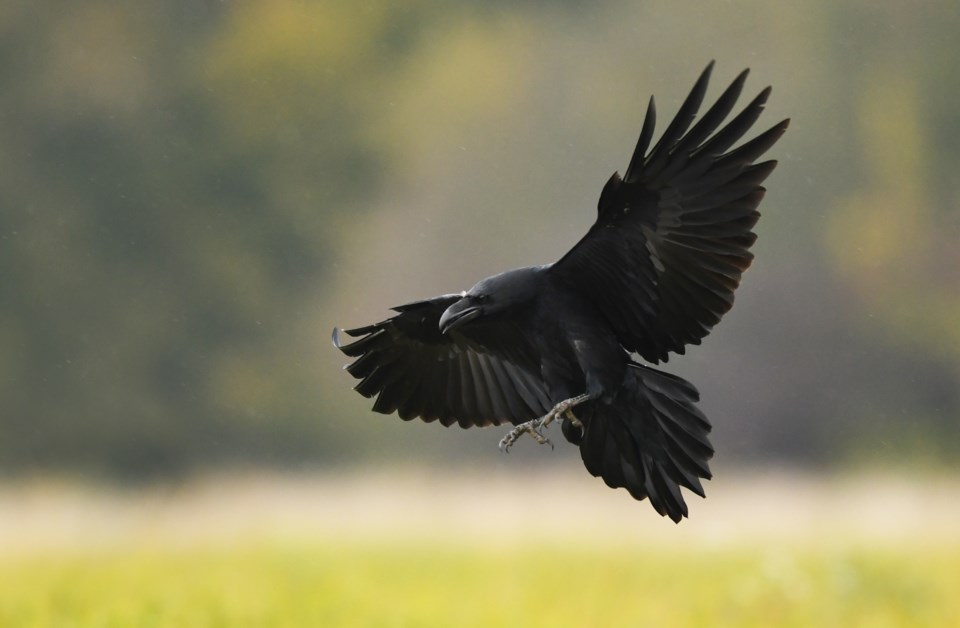WESTERN PRODUCER — Ravens and other birds are among the range of predators that can harm or kill livestock.
Cam Hill, program co-ordinator with the British Columbia Cattlemen’s Association livestock protection program, says program verifiers are trained to determine the cause of livestock kills by wolves, coyotes, bears or cougars.
“We are also seeing increases in bird kills, generally ravens, although eagles are sometimes accused as well. This is the fourth year for me in the role of program co-ordinator. When I first took it over, I went through the records from earlier years and found that we’d averaged seven raven losses per year that we verified and paid compensation on.
“Then in my very first year we had 37 in just that one year. I did some research on this and found articles from three Canadian provinces and one western state in the U.S. and also from Sweden that told about losses to ravens. I became curious as to why and how this happens.”
Ravens are larger than crows or magpies and cattle seem to have an instinctive fear of them and of any large predatory bird. Especially when calves are young, a group of ravens flying over the calving ground will upset the cows just as much as coyotes or wolves do.
“Ravens are quick and deadly,” says Hill. “One producer was watching a cow calving on a grassy hillside. He was watching with binoculars and saw a raven land near the cow and the calf was still in the birth canal.
“The raven hopped onto the calf and made one quick peck. The rancher didn’t realize at first what had happened but as soon as the calf was fully born, he jumped on his quad and drove up there, and found the calf was dead and its eye was gone.
“That year I examined 37 files regarding calves and lambs killed by ravens and it was almost always the same scenario. The eyes, the rear vents and soles of the feet were pecked away, and the navel.
“It was often all of those sites … but in 95 percent of cases, the eye was the first strike area.”
A deep peck can damage the brain but can also cause extensive bleeding. A cow is helpless to protect a calf while still in labour and the birds can take full advantage.
“Some of the producers I’ve talked to had not yet recognized this as a problem and were upset and frustrated that these calves were dead. We know that if a calf is born dead or dies soon after birth from other causes, birds will peck out their eyes,” says Hill.
“So, this has to be part of the verification process. Once you have seen it, however, you can tell right away that the calf was still alive and died from an eye strike because they bleed profusely from the eye socket. There is blood all over the side of the face.”
Hill said ranchers are beginning to recognize ravens as predators and they can be compensated for calves killed by the birds.
Newborns are most vulnerable and can be attacked while asleep with one quick peck.
“The calf bawls and its tongue comes out, and the raven will also snip off the tongue and eat it. It almost looks like someone has cut off the tongue with shears,” Hill explains. The calf dies and becomes a food source for the birds.
Eagles sometimes feed on carcasses and ranchers may blame them for the deaths.
“In my opinion, bald eagles are getting a bum rap. They are generally just scavengers, whereas golden eagles are the hunters/predators.
“Bald eagles are more timid. If the animal moves, bald eagles will fly away because they fear it. But I’ve watched golden eagles in the mountains, and one time watched one try to knock a wild goat kid off the side of a cliff.”
Every year Hill sees a few cases where producers think eagles caused a problem but ravens were the more likely culprits.
Dr. Eugene Janzen of the University of Calgary has been doing necropsies for ranchers for decades.
“Depredation is a big issue for veterinarians doing necropsies, and for the livestock industry, to figure out the difference between scavenged animals and predation. Wildlife conservation officers are often called to verify kills because the rancher can be compensated if it is a kill,” Janzen said.
Predators are opportunists and will prey on any animal that is impaired.
“For instance, in central B.C. in the Nicola Valley, ticks in that area have a neurotoxin and any cattle that have very many ticks suffer from tick paralysis. The animals may collapse and be vulnerable to predators unless you find them in time and pick the ticks off,” said Janzen.
“When we were working with one ranch, it was not uncommon to find some cattle later with their eyes pecked out and their tongue pecked off, or if a coyote came along, it would eat out their rear end. Some of these animals were so severely injured that we’d have to destroy them.”
Birds pecking at raw tissue can cause serious problems and sometimes death of the affected animal.
“Occasionally I’ve seen animals that prolapse and if the cattle aren’t being checked closely every day or the stockman or cowboys don’t see that animal, ravens peck at it. If they peck through the vaginal tissue, some of those animals eviscerate; the intestines come out through that opening,” says Janzen.
“By the time we find them, they will be dead, or still alive with the intestines hanging out the back. People rarely talk about that as being predation, but it is.”

